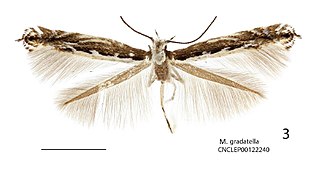
Medicago is a genus of flowering plants, commonly known as medick or burclover, in the legume family (Fabaceae). It contains at least 87 species and is distributed mainly around the Mediterranean Basin, and extending across temperate Eurasia and sub-Saharan Africa. The best-known member of the genus is alfalfa, an important forage crop, and the genus name is based on the Latin name for that plant, medica, from Greek: μηδική (πόα) Median (grass). Most members of the genus are low, creeping herbs, resembling clover, but with burs. However, alfalfa grows to a height of 1 meter, and tree medick is a shrub. Members of the genus are known to produce bioactive compounds such as medicarpin and medicagenic acid. Chromosome numbers in Medicago range from 2n = 14 to 48.

Lathyrus is a genus of flowering plants in the legume family Fabaceae, and contains approximately 160 species. Commonly known as peavines or vetchlings, they are native to temperate areas, with a breakdown of 52 species in Europe, 30 species in North America, 78 in Asia, 24 in tropical East Africa, and 24 in temperate South America. There are annual and perennial species which may be climbing or bushy. This genus has numerous sections, including Orobus, which was once a separate genus. The genus has numerous synonyms, including Pisum, the ancient Latin name for the pea.

The burnet companion moth is a moth of the family Erebidae. It is found in most of the Palearctic realm, from Ireland in the west to Mongolia and Siberia in the east and south to the Mediterranean and North Africa.

A crop wild relative (CWR) is a wild plant closely related to a domesticated plant. It may be a wild ancestor of the domesticated (cultivated) plant or another closely related taxon.
Phyllonorycter trifoliella is a moth of the family Gracillariidae. It is known from Estonia, Georgia, Latvia, Lithuania and the Krasnodar Region of Russia.

Phyllonorycter insignitella is a moth of the family Gracillariidae. It is found in all of Europe, except the Balkan Peninsula.
Phyllonorycter medicaginella is a moth of the family Gracillariidae. It is found from Denmark and Poland to Belgium, the Alps, Bulgaria and Ukraine.

Phyllonorycter nigrescentella is a moth of the family Gracillariidae. It is known from all of Europe except the Balkan Peninsula.

Micrurapteryx gradatella is a moth of the family Gracillariidae. It is found from Fennoscandia to the Iberian Peninsula, the Alps and Romania and from Germany to central Russia, as well as in Tajikistan, the Urals, Siberia, and the Russian Far East.
Protolithocolletis lathyri is a moth of the family Gracillariidae. It is known from California and Michigan in the United States and from British Columbia east to Manitoba in Canada.
Porphyrosela minuta is a moth of the family Gracillariidae. It is known from Argentina, Brazil and Chile. It has been recently introduced in North America and is found in several states, as far north as Maryland.
Phyllonorycter memorabilis is a moth of the family Gracillariidae. It is known from California, United States.
Phyllonorycter fabaceaella is a moth of the family Gracillariidae. It is known from Tajikistan.

Micrurapteryx occulta is a moth of the family Gracillariidae. It is recorded from across North America in the northern half of the continent, in Canada from the Maritime Provinces to British Columbia, north to northernmost Yukon. In the United States it has been found in Connecticut, Kentucky, Illinois, Colorado, Utah, Nevada, and California. The habitat consists of meadows, the edge of forests, open ponderosa pine forests, alpine meadows, the sea shore, and probably other habitats, from sea level to high elevations in the mountains, where suitable hosts occur.

Aproaerema anthyllidella is a moth of the family Gelechiidae. It is found in most of Europe, Kyrgyzstan, Iran and North America.

Athrips tetrapunctella is a moth of the family Gelechiidae. It is found in France, Great Britain, Ireland, Fennoscandia, Denmark, Estonia, Latvia, Russia and Ukraine. In the east, the range extends through the southern Ural and Siberia to Primorsky Krai.

Xystophora pulveratella is a moth of the family Gelechiidae. It is found from central and northern Europe to the Ural Mountains and southern Siberia.

Micrurapteryx caraganella is a moth of the family Gracillariidae. It is found in Siberia, and possibly Tajikistan and the Russian Far East.

Trachusa byssina is a species of bees within the genus Trachusa.











